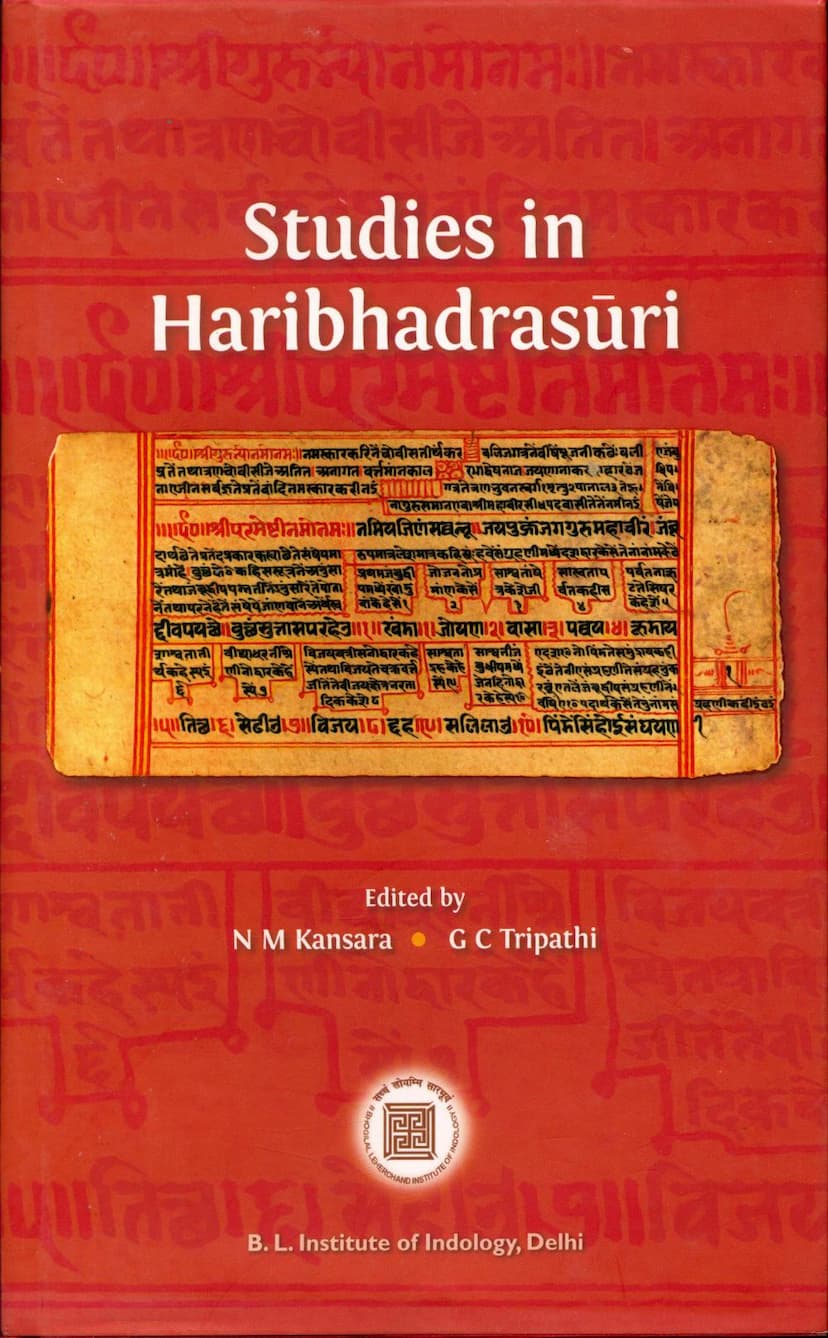Studies In Haribhadrasuri
Added to library: September 2, 2025

Summary
This document is an excerpt from "Studies in Haribhadrasūri," a collection of papers presented at seminars dedicated to the influential Jain philosopher and scholar Haribhadrasūri. The book was edited by N. M. Kansara and G. C. Tripathi and published by the B. L. Institute of Indology, Delhi.
The provided pages (1-158) offer insights into various aspects of Haribhadrasūri's extensive work, covering his contributions to different philosophical and religious domains. Here's a summary of the key themes and discussions presented in these pages:
Overall Context:
- Purpose of the Book: "Studies in Haribhadrasūri" aims to explore the life and works of Haribhadrasūri, a significant figure in Jainism who lived roughly between the 8th century AD. The collection highlights his intellectual breadth, his ability to synthesize different philosophical traditions, and his lasting impact on Jain thought and practice.
- Haribhadrasūri's Profile: He is described as a versatile genius, a learned Brahmin who converted to Jainism. His vast literary output, covering logic, philosophy, yoga, religious practices, and narratives, is a testament to his scholarship. He is noted for his command of both Prakrit and Sanskrit and his ability to engage with and critique Vedic and Buddhist traditions while maintaining a spirit of catholicity and impartiality.
Key Thematic Sections:
The papers are broadly categorized into five sections:
-
Haribhadra and Yoga:
- Yoga-śataka: The paper by Dayanand Bhargava analyzes Haribhadra's Yoga-śataka, highlighting his emphasis on right knowledge preceding right faith and his practical, commonsense approach to yoga. Haribhadra's definition of yoga as that which leads to liberation is discussed, along with his integration of secular morality and spiritual discipline.
- Patañjali vs. Haribhadrasūri's Yoga: Gokul Chandra Jain compares the yoga systems of Patañjali and Haribhadrasūri, noting similarities in practice and ethical foundations despite different terminology. The paper discusses their concepts of Puruṣa and Prakṛti (Patañjali) versus Jīva and A-jīva (Haribhadra) and the theories of bondage and liberation.
- Contribution to Yoga-Vidyā: Ramjee Singh examines Haribhadra's significant contribution to yoga-vidyā, including his novel definition of yoga and his correlation of Jaina spiritual stages (guņa-sthānas) with meditative stages. Haribhadra is credited with establishing a fundamental unity among various Indian thought systems regarding spiritual liberation.
- Buddhist Source of Eight Drstis: N. M. Tantia traces the eight stages (dṛṣṭis) in Haribhadra's Yoga-dṛṣṭi-samuccaya to Buddhist sources, particularly Vasubandhu's Abhidharma-kośa-bhāṣya. The paper highlights the striking parallelism and Haribhadra's synthesis of these ideas within a Jaina framework.
-
Haribhadra and Nyāya:
- Jaina Concept of Causality: L. C. Jain analyzes the Jaina concept of causality in Haribhadra's Ṣaḍ-darśana-samuccaya, focusing on the role of time-fluid (kāla-dravya). The paper draws parallels between Jaina concepts and modern physics, particularly Einstein's theories, and emphasizes the need for interdisciplinary studies.
- Commentary on Nyāya-praveśa: K. K. Mittal discusses Haribhadra's commentary on the Nyāya-praveśa and its place in Buddhist logic. The paper explores the complex history of the Nyāya-praveśa's authorship and the challenges of tracing Haribhadra's commentary due to historical circumstances.
-
Haribhadra and Religious Worship:
- Ambā-kuṣmāṇḍī-vidyā: U. P. Shah delves into two interesting references by Haribhadrasūri concerning the Ambā-kuṣmāṇḍī-vidyā. The paper explores the potential Tantric origins of this vidyā, its association with the Jaina Yakṣī Ambikā, and the fusion of various ancient deities in its development. It also examines the terrifying form of Durgā referred to as Kottakiriyā.
- Temple Construction and Worship: N. R. Banerjee analyzes chapters from Haribhadra's Ṣoḍaśaka concerning temple construction, image installation, and worship. The paper highlights Haribhadra's modern, humanistic, and scientific approach, emphasizing ethical considerations in acquiring wealth, acquiring land, using materials, and paying workmen, reflecting his concern for social justice.
-
Haribhadra and Religio-Philosophical Outlook:
- Advocate of Eve-Salvation: S. P. Narang examines Haribhadrasūri's arguments in the Lalita-vistara supporting the possibility of women attaining salvation. The paper refutes traditional arguments that disqualified women, emphasizing Haribhadra's rational, multidimensional approach, and his advocacy for the equality of women.
- A Legend in Catholicity: M. L. Jain portrays Haribhadrasūri as a legend in catholicity, emphasizing his ability to reconcile different spiritual traditions and his belief in universal truth accessible through reason and practice, irrespective of sectarian differences. His quote advocating for accepting logical propositions regardless of their origin is highlighted.
-
Some Religious Works of Haribhadrasūri:
- Vimśati-Vimśatikā: V. M. Kulkarni analyzes Haribhadrasūri's Vimśati-vimśatikā, discussing its title, structure, language (Jaina Māhārāstrī), and its comprehensive coverage of important Jaina topics. The need for a critical edition of the work is also noted.
- Loka-tattva-nirnaya: R. S. Betai discusses the Loka-tattva-nirṇaya, focusing on Haribhadra's concepts of God and man. The paper outlines Haribhadra's rejection of a creator God and his emphasis on the self-existent and eternal nature of the universe and the soul's journey through karma.
- Critical Study of Loka-tattva-nirnaya: J. B. Shah provides a critical study of the Loka-tattva-nirṇaya, questioning its popular title and proposing Nr-tattva-nigama based on the author's introductory verse. The paper analyzes Haribhadra's views on Jīva, Jagat, and Īśvara, emphasizing his impartial approach and his definition of divinity based on virtuous qualities.
- Authorship of Pañca-sūtra: Śīlacandravijaya Gaṇi (now Vijaya-Shilachandra Suri) addresses the debated authorship of the Pañca-sūtra, presenting arguments for and against Haribhadrasūri being the author. The paper analyzes linguistic similarities, stylistic features, and manuscript evidence to support the thesis that Haribhadrasūri likely authored both the Pañca-sūtra and its commentary, challenging traditional views.
In essence, these pages showcase Haribhadrasūri as a pivotal figure who synthesized Indian philosophical traditions, contributed significantly to Jain yoga and logic, and championed inclusive and rational approaches to religious thought and practice, notably in his advocacy for women's spiritual equality.